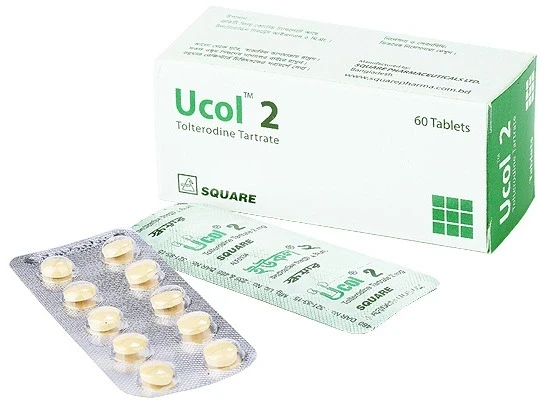



Urolosin-D Capsule, Tamsulosin Hydrochloride + Dutasteride 0.4 mg+0.5 mg
Inhouse product
-
৳11.40
৳12.00 -
৳42.75
৳45.00 -
৳16.63
৳17.50 -
৳2.14
৳2.25
Reviews & Ratings
Indications
Urolosin-D capsule is
indicated in-
- Treatment of moderate to severe
symptoms of benign prostatic hyperplasia (BPH).
- Reduction in the risk of acute
urinary retention and surgery in patients with moderate to severe symptoms
of BPH.
* রেজিস্টার্ড চিকিৎসকের পরামর্শ মোতাবেক ঔষধ সেবন করুন'
Pharmacology
Tamsulosin &
Dutasteride is a combination of two drugs with complementary mechanisms of
action to improve symptoms in patients with Benign Prostatic Hyperplasia (BPH).
Tamsulosin Hydrochloride, an antagonist of alpha1A-adrenoreceptors
and Dutasteride, a dual 5 alpha reductase inhibitor (5ARI). Treatment of BPH
with alpha1-adrenoreceptor blocking agents and 5ARIs results in an
improvement in urine flow rate and a reduction in symptoms of BPH.
Tamsulosin: An alpha1-adrenoreceptor blocking agent that
affects the dynamic component of BPH by inhibiting alpha1-adrenoreceptors
in the stromal prostatic smooth muscle and bladder neck. Blockade of these
adrenoreceptors can cause smooth muscles in the bladder neck and prostate to
relax. Specifically, Tamsulosin exhibits selectivity for both alpha 1A and
alpha 1D receptors over the alpha1B-adrenoreceptor
subtype. These three adrenoreceptor subtypes have a distinct distribution
pattern in human tissue. Whereas approximately 70% of the alpha1-receptors
in human prostate are of the alpha 1A subtype, the human
bladder contains predominantly the alpha 1D subtype while
blood vessels express predominantly alpha 1B subtype. It
is further believed that blockade of the alpha 1D subtypes
in the human obstructed bladder may be responsible for reducing detrusor
overactivity and subsequent relief of storage symptoms.
Dutasteride: A synthetic 4-azasteriod compound is a
competitive and specific inhibitor of both Type I and Type II 5 alpha-reductase
isoenzymes that affects the static component of BPH by inhibiting the
conversion of Testosterone to Dihydrotestosterone (DHT) by the enzyme 5 alpha-reductase.
5 alpha-reductase exists as 2 isoforms, Type I and Type II, both of which are
present in the prostate. It has been observed that compared to normal tissue,
the expression of both isoenzymes are increased in BPH tissue. Dissociation
from this complex has been evaluated under in vitro and in vivo conditions and
is extremely slow. Dutasteride lowers DHT levels and leads to a reduction in
prostatic volume, thereby treating an underlying cause of BPH. Dutasteride does
not bind to the human androgen receptor.
Dosage &
Administration
Adults (including
elderly): The recommended dose
is one capsule (Tamsulosin Hydrochloride 0.4 mg & Dutasteride 0.5 mg) taken
orally approximately 30 minutes after the same meal each day. The capsules
should be swallowed whole and not chewed or opened. Where appropriate, this
capsule may be used to substitute concomitant Tamsulosin Hydrochloride and
Dutasteride in existing dual therapy to simplify treatment. Where clinically
appropriate, direct change from Tamsulosin Hydrochloride or Dutasteride
monotherapy to this capsule may be considered.
Renal impairment: The effect of renal impairment on
Tamsulosin-Dutasteride pharmacokinetics has not been studied. No adjustment in
dosage is anticipated for patients with renal impairment.
Hepatic impairment: The effect of hepatic impairment on
Tamsulosin-Dutasteride pharmacokinetics has not been studied so caution should
be used in patients with mild to moderate hepatic impairment. In patients with
severe hepatic impairment, the use of this capsule is contra-indicated.
* রেজিস্টার্ড চিকিৎসকের পরামর্শ মোতাবেক ঔষধ সেবন করুন'
Interaction
There have been no
drug interaction studies for Dutasteride-Tamsulosin combination.
Effects of other drugs
on the pharmacokinetics of Dutasteride: Use together with CYP3A4 and/or P-glycoprotein-inhibitors:
Dutasteride is mainly eliminated via metabolism. In vitro studies indicate that
this metabolism is catalysed by CYP3A4 and CYP3A5. No formal interaction
studies have been performed with potent CYP3A4 inhibitors. However, in a
population pharmacokinetic study, Dutasteride serum concentrations were on average
1.6 to 1.8 times greater, respectively, in a small number of patients treated
concurrently with verapamil or diltiazem (moderate inhibitors of CYP3A4 and
inhibitors of P-glycoprotein) than in other patients. Long-term combination of
Dutasteride with drugs that are potent inhibitors of the enzyme CYP3A4 (e.g.
ritonavir, indinavir, nefazodone, itraconazole, ketoconazole administered
orally) may increase serum concentrations of Dutasteride. Further inhibition of
5-alpha reductase at increased Dutasteride exposure, is not likely. However, a
reduction of the Dutasteride dosing frequency can be considered if side effects
are noted. It should be noted that in the case of enzyme inhibition, the long
half-life may be further prolonged and it can take more than 6 months of
concurrent therapy before a new steady state is reached. Administration of 12 g
cholestyramine one hour after a 5 mg single dose of Dutasteride did not affect
the pharmacokinetics of Dutasteride.
Effects of Dutasteride
on the pharmacokinetics of other drugs: In a small study (N=24) of two weeks duration in healthy men,
Dutasteride (0.5 mg daily) had no effect on the pharmacokinetics of Tamsulosin
or terazosin. There was also no indication of a pharmacodynamic interaction in
this study. Dutasteride has no effect on the pharmacokinetics of warfarin or
digoxin. This indicates that Dutasteride does not inhibit/induce CYP2C9 or the
transporter P-glycoprotein. In vitro interaction studies indicate that
Dutasteride does not inhibit the enzymes CYP1A2, CYP2D6, CYP2C9, CYP2C19 or
CYP3A4. Tamsulosin: Concomitant administration of Tamsulosin Hydrochloride with
drugs which can reduce blood pressure, including anaesthetic agents, PDE5
inhibitors and other alpha-1 adrenergic blockers could lead to enhanced hypotensive
effects. Tamsulosin-Dutasteride should not be used in combination with other
alpha-1 adrenergic blockers. Concomitant administration of Tamsulosin
Hydrochloride (0.4 mg) and cimetidine (400 mg every six hours for six days)
resulted in a decrease in the clearance (26%) and an increase in the AUC (44%)
of Tamsulosin Hydrochloride. Caution should be used when Tamsulosin-Dutasteride
is used in combination with cimetidine. A definitive drug-drug interaction
study between Tamsulosin Hydrochloride and warfarin has not been conducted.
Results from limited in vitro and in vivo studies are inconclusive. Caution
should be exercised with concomitant administration of warfarin and Tamsulosin
Hydrochloride. No interactions have been seen when Tamsulosin Hydrochloride was
given concomitantly with either atenolol, enalapril, nifedipine or
theophylline. Concomitant furosemide brings about a fall in plasma levels of
Tamsulosin, but as levels remain within the normal range posology need not be
adjusted. In vitro neither diazepam nor propranolol, trichlormethiazide,
chlormadinon, amitryptyline, diclofenac, glibenclamide and simvastatin change
the free fraction of Tamsulosin in human plasma. Neither does Tamsulosin change
the free fractions of diazepam, propranolol, trichlormethiazide, and
chlormadinon. No interactions at the level of hepatic metabolism have been seen
during in vitro studies with liver microsomal fractions, involving
amitriptyline, salbutamol and glibenclamide. Diclofenac however, may increase
the elimination rate of Tamsulosin.
Contraindications
Tamsulosin-Dutasteride
combination is contra-indicated in women and children and adolescents, patients
with hypersensitivity to Dutasteride, other 5-alpha reductase inhibitors,
Tamsulosin (including Tamsulosin- induced angio-edema), soya, peanut or any of
other the excipients, patients with a history of orthostatic hypotension and
patients with severe hepatic impairment.
Side Effects
The most common
adverse reactions reported in subjects receiving combination therapy were
impotence, decreased libido, breast disorders (including breast enlargement and
tenderness), ejaculation disorders and dizziness. The percentages of subjects
with ejaculation disorders, decreased libido and impotence were higher in the
combination therapy group compared with either monotherapy groups.
Pregnancy &
Lactation
Tamsulosin-Dutasteride
combination is contra-indicated for use by women. There have been no studies to
investigate the effect of Tamsulosin-Dutasteride combination on pregnancy, lactation
and fertility. The following statements reflect the information available from
studies with the individual components. Fertility: Dutasteride has been
reported to affect semen characteristics (reduction in sperm count, semen
volume, and sperm motility) in healthy men. The possibility of reduced male
fertility cannot be excluded. Effects of Tamsulosin Hydrochloride on sperm
counts or sperm function have not been evaluated.
Pregnancy: As with other 5 alpha reductase inhibitors,
Dutasteride inhibits the conversion of testosterone to dihydrotestosterone and
may, if administered to a woman carrying a male foetus, inhibit the development
of the external genitalia of the foetus. Small amounts of Dutasteride have been
recovered from the semen in subjects receiving Dutasteride. It is not known
whether a male foetus will be adversely affected if his mother is exposed to
the semen of a patient being treated with Dutasteride. As with all 5 alpha
reductase inhibitors, when the patient’s partner is or may potentially be
pregnant it is recommended that the patient avoids exposure of his partner to
semen by use of a condom. Administration of Tamsulosin Hydrochloride to
pregnant female rats and rabbits showed no evidence of foetal harm.
Lactation: It is not known whether Tamsulosin or
Dutasteride are excreted in human milk.
Precautions &
Warnings
Combination therapy
should be prescribed after careful benefit risk assessment due to the potential
increased risk of adverse events (including cardiac failure) and after consideration
of alternative treatment options including monotherapies.
Cardiac failure: In two 4-year clinical studies, the
incidence of cardiac failure was higher among subjects taking the combination
of Dutasteride and an alpha blocker, primarily Tamsulosin, than it was among
subjects not taking the combination. In these two trials, the incidence of
cardiac failure was low (1%) and variable between the studies.
Effects on prostate
specific antigen (PSA) and prostate cancer detection: Digital rectal examination, as well as other
evaluations for prostate cancer or other conditions which can cause the same
symptoms as BPH, must be performed on patients prior to initiating therapy with
Tamsulosin-Dutasteride combination and periodically thereafter. Serum prostate-specific
antigen (PSA) concentration is an important component in the detection of
prostate cancer. Tamsulosin-Dutasteride combination causes a decrease in mean
serum PSA levels by approximately 50%, after 6 months of treatment. Patients
receiving Tamsulosin-Dutasteride combination should have a new PSA baseline
established after 6 months of treatment. It is recommended to monitor PSA
values regularly thereafter. Any confirmed increase from lowest PSA level while
on Tamsulosin-Dutasteride combination may signal the presence of prostate
cancer or noncompliance to therapy with Tamsulosin-Dutasteride combination and
should be carefully evaluated, even if those values are still within the normal
range for men not taking a 5 alpha-reductase inhibitor. In the interpretation
of a PSA value for a patient taking Tamsulosin-Dutasteride combination,
previous PSA values while on Dutasteride treatment should be sought for
comparison. Treatment with Tamsulosin-Dutasteride combination does not
interfere with the use of PSA as a tool to assist in the diagnosis of prostate
cancer after a new baseline has been established. Total serum PSA levels return
to baseline within 6 months of discontinuing treatment. The ratio of free to
total PSA remains constant even under the influence of Tamsulosin-Dutasteride
combination. If clinicians elect to use percent free PSA as an aid in the
detection of prostate cancer in men undergoing Tamsulosin-Dutasteride
combination therapy, no adjustment to its value appears necessary.
Prostate cancer and
high grade tumours: Results of one
clinical study in men at increase risk of prostate cancer revealed a higher
incidence of Gleason 8-10 prostate cancers in Dutasteride treated men compared
to placebo. The relationship between Dutasteride and high grade prostate cancer
is not clear. Men taking Tamsulosin-Dutasteride combination should be regularly
evaluated for prostate cancer risk including PSA testing.
Renal impairment: The treatment of severely renally impaired
patients (creatinine clearance of less than 10 ml/min) should be approached
with caution as these patients have not been studied.
Hypotension: Orthostatic- As with other alpha-blockers, a
reduction in blood pressure can occur during treatment with Tamsulosin, as a
result of which, rarely, syncope can occur. Patients beginning treatment with
Tamsulosin-Dutasteride combination should be cautioned to sit or lie down at
the first signs of orthostatic hypotension (dizziness, weakness) until the
symptoms have resolved. In order to minimize the potential for developing
postural hypotension the patient should be haemodynamically stable on
alpha-blocker therapy prior to initiating use of PDE5 inhibitors. Symptomatic:
Caution is advised when alpha adrenergic blocking agents including Tamsulosin
are coadministered with PDE5 inhibitors (e.g. sildenafil, tadalafil,
vardenafil). Alpha adrenergic blockers and PDE5 inhibitors are both
vasodilators that can lower blood pressure. Concomitant use of these two drug
classes can potentially cause symptomatic hypotension.
Intraoperative Floppy
Iris Syndrome: Intraoperative
Floppy Iris Syndrome (IFIS) has been observed during cataract surgery in some
patients on or previously treated with Tamsulosin. IFIS may lead to increased
procedural complications during the operation. The initiation of therapy with
Tamsulosin-Dutasteride combination in patients for whom cataract surgery is
scheduled is therefore not recommended. Discontinuing Tamsulosin 1-2 weeks
prior to cataract surgery is anecdotally considered helpful, but the benefit
and duration of stopping therapy prior to cataract surgery has not yet been
established. Leaking Capsule: Dutasteride is absorbed through the skin,
therefore, women, children and adolescents must avoid contact with leaking
capsules. If contact is made with leaking capsules, the contact area should be
washed immediately with soap and water.
Hepatic impairment: Tamsulosin-Dutasteride combination has not
been studied in patients with liver disease. Caution should be used in the
administration of Tamsulosin-Dutasteride combination to patients with mild to
moderate hepatic impairment.
Breast neoplasia: Breast cancer has been reported in men
taking Dutasteride in clinical trials and during the post-marketing period.
Physicians should instruct their patients to promptly report any changes in
their breast tissue such as lumps or nipple discharge. Currently it is not
clear if there is a causal relationship between the occurrence of male breast
cancer and long term use of Dutasteride.
Overdose Effects
No data are available
with regard to over dosage of Tamsulosin-Dutasteride combination. The following
statements reflect the information available on the individual components.
Dutasteride: In volunteer studies, single daily doses of
Dutasteride up to 40 mg/day (80 times the therapeutic dose) have been
administered for 7 days without significant safety concerns. In clinical
studies, doses of 5 mg daily have been administered to subjects for 6 months
with no additional adverse effects to those seen at therapeutic doses of 0.5
mg. There is no specific antidote for Dutasteride, therefore, in suspected over
dosage symptomatic and supportive treatment should be given as appropriate.
Tamsulosin: Acute overdose with 5 mg Tamsulosin
Hydrochloride has been reported. Acute hypotension (systolic blood pressure 70
mm Hg), vomiting and diarrhoea were observed which were treated with fluid
replacement and the patient could be discharged the same day. In case of acute
hypotension occurring after over dosage cardiovascular support should be given.
Blood pressure can be restored and heart rate brought back to normal by lying
the patient down. If this does not help then volume expanders, and when
necessary, vasopressors could be employed. Renal function should be monitored
and general supportive measures applied. Dialysis is unlikely to be of help as
Tamsulosin is very highly bound to plasma proteins. Measures, such as emesis,
can be taken to impede absorption. When large quantities are involved, gastric
lavage can be applied and activated charcoal and an osmotic laxative, such as
sodium sulphate, can be administered.
Therapeutic Class
BPH/ Urinary
retention/ Urinary incontinence
Storage Conditions
Store in a cool and
dry place, protected from light.
Frequently Bought Products
DLP Capsule (Enteric Coated), Dexlansoprazole 30 mg
Ucol Tablet, Tolterodine Tartrate 2 mg
Eprim Plus Capsule, Evening primrose oil 1000 mg
Daizy Tablet, Dienogest 2 mg
Digac Syrup 200 ml bottle, Jamani Arka
Toroaid Tablet, Ketorolac Tromethamine 10 mg
Virux-HC Cream 10 gm, Acyclovir + Hydrocortisone 5%+1%
Product Queries (0)
Login Or Registerto submit your questions to seller
Other Questions
No none asked to seller yet
-
৳11.40
৳12.00 -
৳42.75
৳45.00 -
৳16.63
৳17.50 -
৳2.14
৳2.25

















